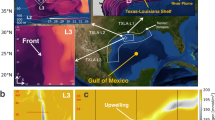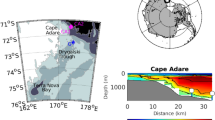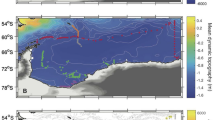Abstract
THE spreading of Antarctic Bottom Water—the densest global-scale water mass—is highly constrained by ocean-floor topography. In the Atlantic Ocean, the Mid-Atlantic Ridge confines this water mass mainly to the western basins, the bottom waters in the eastern basins being renewed by flows through gaps in the ridge1. One such gap is the Romanche fracture zone, a large offset of the ridge which straddles the Equator. It has been observed2 that sills within this fracture zone block the passage of waters colder than ∼0.9 °C; warmer, less dense waters passing over the sills appear to cascade downslope where they are modified by mixing. Here we present direct measurements which quantify these processes. The flow is vertically sheared and exhibits remarkably intense turbulence, comparable to that seen at the ocean surface in the presence of winds of ∼l0ms −1. This turbulence mixes the densest waters passing through the fracture zone with the warmer, overlying waters, so that the coldest waters exiting this region have been warmed by ∼0.6 °C during transit. Topographic obstructions and turbulent mixing together thus determine the properties of the flows renewing the deepest waters of the Atlantic Ocean's eastern basins.
This is a preview of subscription content, access via your institution
Access options
Subscribe to this journal
Receive 51 print issues and online access
$199.00 per year
only $3.90 per issue
Buy this article
- Purchase on Springer Link
- Instant access to full article PDF
Prices may be subject to local taxes which are calculated during checkout
Similar content being viewed by others
References
Wüst, G. Das Bodenwasser und die Gliedenung der Atlantischen Tiefsee. in Wissenschaftliche Ergebnisse der Deutschen Atlantischen Expedition auf dem Forschungs- und Vermes-sungsschiff “Meteor” 1925–1927, Vol. 6(1), 1–107 (Gruyter, Berlin, 1933).
Mercier, H., Speer, K. G. & Honnorez, J. Deep-Sea Res. 41, 1457–1477 (1994).
Garrett, C. & Munk, W. Deep-Sea Res. 19, 823–832 (1972).
Gargett, A. E. & Holloway, G. J. mar. Res. 42, 15–27 (1984).
Munk, W. H. Deep-Sea Res. 13, 707–730 (1966).
Armi, L. J. geophys. Res. 83, 1971–1979 (1978).
Eriksen, C. C. J. phys. Oceanogr. 15, 1145–1156 (1985).
Bell, T. H. J. geophys. Res. 80, 320–327 (1975).
Toole, J. M., Polzin, K. L. & Schmitt, R. W. Science 264, 1120–1123 (1994).
Kunze, E. & Sanford, T. M. J. phys. Oceanogr. (submitted).
Schmitt, R. W., Toole, J. M., Koehler, R. L., Doherty, K. & Mellinger, E. J. Atmos. Oceanic Technol. 5, 484–500 (1988).
Monti, S. & Mercier, H. Bathymetric Map of the Romanche Fracture Zone (IFREMER, Brest, France, 1991).
Bryden, H. L. & Stommel, H. M. Oceanologica Acta 7, 289–296 (1984).
Miles, J. W. & Howard, L. N. J. Fluid Mech. 10, 496–512 (1961).
Thorpe, S. A. J. Fluid Mech. 61, 731–751 (1973).
Armi, L. J. Fluid Mech. 163, 27–58 (1986).
Long, R. R. Bull. Am. met. Soc. 34, 205–211 (1953).
Tennekes, H. & Lumley, J. L. A First Course in Turbulence (MIT Press, Cambridge, 1972).
Osborn, T. R. J. phys. Oceanogr. 10, 83–89 (1980).
McCartney, M. S. & Curry, R. A. J. phys. Oceanogr. 23, 1264–1276 (1993).
Warren, B. A. & Speer, K. G. Deep-Sea Res. (suppl.) 38, s281–s322 (1991).
Schlitzer, R. J. geophys. Res. 92, 2953–2969 (1987).
Whitehead, J. A. & Worthington, L. V. J. geophys. Res. 87, 7903–7924 (1982).
Hogg, N., Biscaye, P., Grdner, W. & Schmitz, W. J. mar. Res. (suppl.) 40, 231–263 (1982).
Saunders, P. M. J. phys. Oceanogr. 17, 631–643 (1987).
Barton, E. D. & Hill, A. E. Deep-Sea Res. 36, 1121–11226 (1989).
Roemmich, D., Hautala, S. & Rudnick, D. J. geophys. Res. (in the press).
Wessen, J. C. & Gregg, M. C. J. geophys. Res. 99, 9847–9878 (1994).
Author information
Authors and Affiliations
Rights and permissions
About this article
Cite this article
Polzin, K., Speer, K., Toole, J. et al. Intense mixing of Antarctic Bottom Water in the equatorial Atlantic Ocean. Nature 380, 54–57 (1996). https://doi.org/10.1038/380054a0
Received:
Accepted:
Issue Date:
DOI: https://doi.org/10.1038/380054a0
This article is cited by
-
Oceanic bottom mixed layer in the Clarion-Clipperton Zone: potential influence on deep-seabed mining plume dispersal
Environmental Fluid Mechanics (2023)
-
Deep circulation in the South China Sea simulated in a regional model
Ocean Dynamics (2020)
-
Strong transport and mixing of deep water through the Southwest Indian Ridge
Nature Geoscience (2008)
-
Intense mixing of lower thermocline water on the crest of the Mid-Atlantic Ridge
Nature (2007)
-
High mixing rates in the abyssal Southern Ocean
Nature (2002)
Comments
By submitting a comment you agree to abide by our Terms and Community Guidelines. If you find something abusive or that does not comply with our terms or guidelines please flag it as inappropriate.



